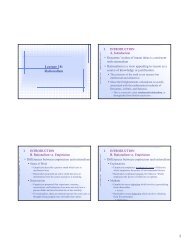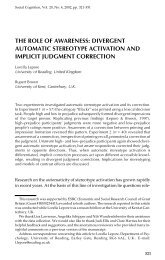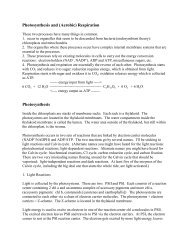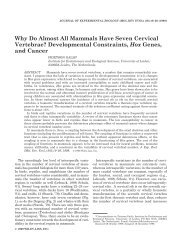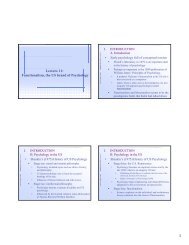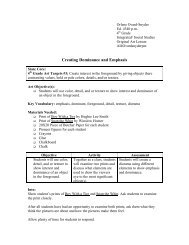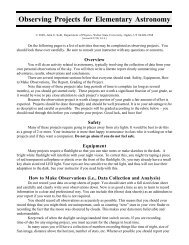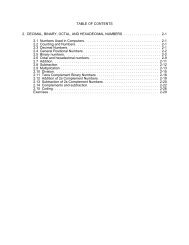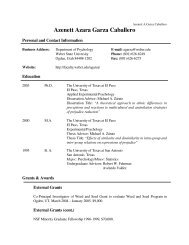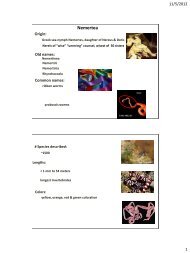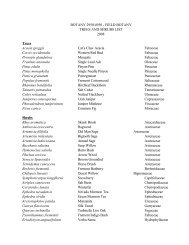Stanovich Chapter 2 Falsifiability: How to Foil the Little Green Men in ...
Stanovich Chapter 2 Falsifiability: How to Foil the Little Green Men in ...
Stanovich Chapter 2 Falsifiability: How to Foil the Little Green Men in ...
You also want an ePaper? Increase the reach of your titles
YUMPU automatically turns print PDFs into web optimized ePapers that Google loves.
<strong>Stanovich</strong> <strong>Chapter</strong> 2<br />
<strong>Falsifiability</strong>: <strong>How</strong> <strong>to</strong> <strong>Foil</strong> <strong>the</strong> <strong>Little</strong><br />
<strong>Green</strong> <strong>Men</strong> <strong>in</strong> <strong>the</strong> Head<br />
Theories<br />
A <strong>the</strong>ory, <strong>in</strong> science, is an <strong>in</strong>terrelated set<br />
of concepts that expla<strong>in</strong>s a set of data.<br />
A <strong>the</strong>ory is used <strong>to</strong> make predictions<br />
about <strong>the</strong> results of future experiments.<br />
Predictions derived from a <strong>the</strong>ory must be<br />
vulnerable <strong>to</strong> falsification.<br />
Be wary of <strong>the</strong>ories that expla<strong>in</strong> everyth<strong>in</strong>g<br />
or fail <strong>to</strong> make predictions.<br />
<strong>Falsifiability</strong><br />
Scientific <strong>the</strong>ories must be stated <strong>in</strong> a way<br />
that predictions derived from <strong>the</strong>m can be<br />
potentially shown <strong>to</strong> be false.<br />
Put ano<strong>the</strong>r way, <strong>in</strong> say<strong>in</strong>g that someth<strong>in</strong>g<br />
should happen, a <strong>the</strong>ory should also say<br />
what should not happen.<br />
The <strong>Little</strong> <strong>Green</strong> <strong>Men</strong> and ESP<br />
<strong>Stanovich</strong> provides us with an example of<br />
an unfalsifiable <strong>the</strong>ory <strong>in</strong> <strong>the</strong> form of little<br />
green men <strong>in</strong> your head that control your<br />
thoughts but dissapear when observed.<br />
While this may seem far fetched <strong>to</strong> <strong>the</strong><br />
po<strong>in</strong>t of be<strong>in</strong>g <strong>in</strong>sult<strong>in</strong>g, such evidence is<br />
often used <strong>to</strong> prove <strong>the</strong> presence of ESP.<br />
10/24/2012<br />
1
<strong>Stanovich</strong><br />
<strong>Chapter</strong> 2 – Part 2<br />
Change and Mistakes<br />
Psychology is look<strong>in</strong>g for conceptual<br />
Change<br />
May challenge beliefs<br />
Mak<strong>in</strong>g Mistakes is not a Total Loss<br />
<strong>Stanovich</strong> calls it “liberat<strong>in</strong>g”<br />
Readjust<strong>in</strong>g <strong>to</strong> make new <strong>the</strong>ories<br />
Quality vs. Quantity of Confirmation<br />
Use falsifiablility criterion <strong>to</strong> evaluate <strong>the</strong><br />
evidence<br />
A high number of confirmations OR<br />
Better, more specific confirmations<br />
F<strong>in</strong>d<strong>in</strong>g Truth<br />
Rare that <strong>the</strong> first idea is <strong>the</strong> right one<br />
Hypo<strong>the</strong>ses are tested and kept or<br />
discarded<br />
New <strong>the</strong>ories keep old, and build on <strong>the</strong>m<br />
Scientists look <strong>to</strong> <strong>the</strong> “fr<strong>in</strong>ge” of what is<br />
known<br />
10/24/2012<br />
2
Take-Home Message<br />
Solvable Problems need Testable Theories<br />
that can be Falsified<br />
Science uses terms like mistake, error, or<br />
falsified<br />
These terms do not mean <strong>the</strong> <strong>the</strong>ory is<br />
completely wrong, only that it is<br />
<strong>in</strong>complete<br />
10/24/2012<br />
3





